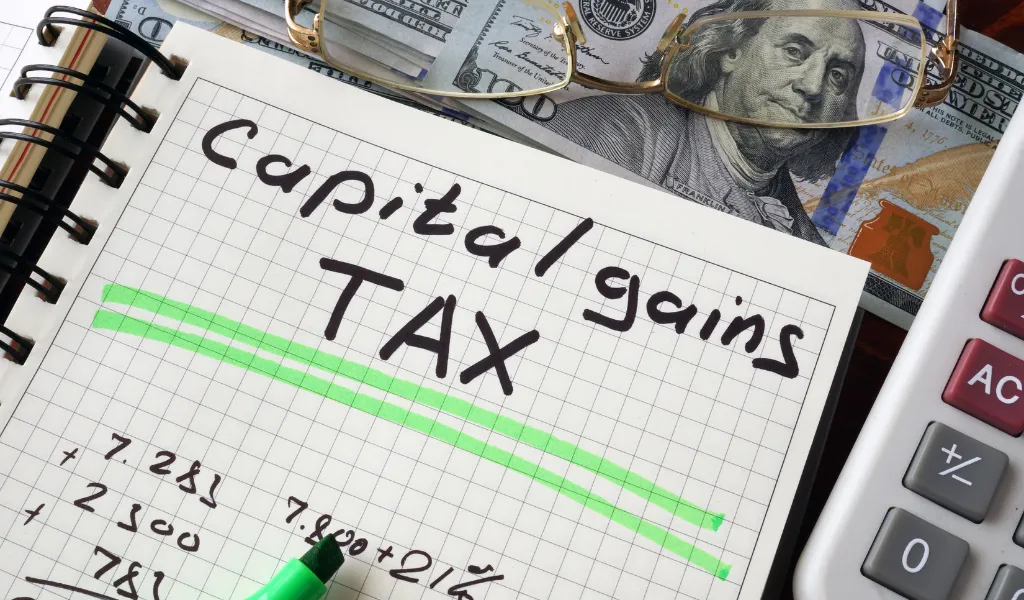As a property owner, you should know how to take full advantage of all available tax reliefs. Otherwise, you end up paying a lot. Most property owners pay a hefty sum of tax because they do not take professional tax advice. When it comes to CGT on Buy-to-Let, is it possible to avoid it?
First, let’s discuss the definition of Capital Gains Tax. Then, we can move on to the ways to avoid paying it or reducing it.
What is Capital Gains Tax?
When you sell or dispose of an asset, you can make a profit from it. Capital Gains Tax applies to that profit or gain and does not apply to the total revenue of the asset.
You are liable for capital gains tax when you make a profit from selling a property that is not your principal residence. For example, buy-to-let property, inheritance of property, land, or business premises.
Suppose you buy a property for £600,000 and sell it for £700,000. The profit made is £100,000, and the CGT is applicable.
Capital Gains Tax is increasing in the same manner as the land prices. This affects the property owners in both a negative and positive way.
However, under certain conditions, you can avoid paying for CGT.

When to Pay CGT on Buy-to-Let?
Nearly all your assets are liable for Capital Gains Tax. That is when you sell or dispose of them and make a profit. However, CGT does not apply to your primary home. CGT applies to the gain from the following assets:
- Personal assets that are worth more than £6,000. This does not include your vehicle.
- Any property other than your primary residence.
- Investments which you did not keep in a Personal Equity Plan or an Individuals Saving Account (ISA).
- Certain business resources.
If you decide to let out part of your principal residence as a rental property, then you pay CGT on the profit you make from it. The same applies if you use it as a business premise.
Within 30 days of selling the property, you need to make CGT payments. During this time, you should notify HMRC about the sale. This is compulsory since 6th April 2020.
What is the CGT Rate on a Buy-to-Let Property?
Capital Gains Tax applies according to your taxable income. It depends on which tax slab rate your income falls under. You either pay according to a basic rate taxpayer or a higher rate taxpayer. Below are the tax rates for 2023/24.
| Tax Band 2023/24 | CGT on Residential Property |
|---|---|
| Annual allowance Gains up to £6,000 | 0% |
| Basic-rate taxpayer £12,571 – £50,270 | 18% |
| Higher/additional rate taxpayer £50,271 + | 28% |
How to Avoid CGT on Buy-to-Let
You cannot completely avoid CGT when you sell your Buy-to-let property. However, there are ways through which you can reduce the amount of CGT you owe.
Following are the methods you can use to minimise your Capital Gains Tax bill:
1. Use Your Tax-Free CGT Allowance
Just as you have your personal tax allowance, you also have an annual CGT personal allowance. Your annual exempt amount is £6,000 as of 2023/24. As a property owner, you should utilise this allowance when you sell a property. If you have no other capital gains in that year.
2. Using Deductions Available to Buy-to-Let
Another way to reduce the amount of CGT you owe is by deducting costs. You can deduct the following costs when selling a property:
- The costs for solicitors.
- Capital improvement costs for extending structures, etc.
- The expense for advertising to find a buyer.
- The fees for estate agents.
- Stamp Duty Land Tax (or an analogous fee) paid when you bought the property.
- The costs of surveyors.
- Active 2: Any expenses incurred for valuation or apportionment necessary to calculate the capital gains tax are allowed. However, accountants’ fees for filing capital gains tax returns or calculating tax liability are not permitted.
3. Live in Your Own Buy to Let
If you let out a property that was once your primary residence, you can qualify for tax relief. This way, you can reduce the CGT on Buy-to-Let.
Capital Gains Tax is not liable on the sale or disposition of your property if all the following apply:
- If you only own one house and have occupied it as your primary residence the whole time, you’ve owned it.
- In case you have let none of it out. Please note that having a lodger is not considered this.
- You haven’t solely utilised a space in your house for work (using a room as an office sometimes or temporarily does not qualify as purely commercial use).
- Also, you must show that more space is necessary for use and enjoyment of the property if the entire area of the grounds, including all structures, exceeds 5,000 square meters (a little more than an acre).
- You didn’t purchase it only to profit from it.
Thus, you can gain eligibility for a tax relief called Principal Residence Relief if all these apply to you. Through this relief, you do not need to pay tax when you sell the property. In case not all of these apply, you may owe some Capital Gains Tax on your property. There are more ways to minimise the CGT on Buy-to-Let.
New Primary Residence
You have the option to nominate a new principal home. Many property owners use this method to avoid paying CGT. However, it is important to reach out to an accountant first.
If you have an empty or un-occupied buy-to-let property, then you should change your primary residence. This way you can reduce the amount of Capital Gains Tax on that buy-to-let property. Please note that you must occupy the property if you want to qualify for this relief.
There is no limit to the number of times you switch your principal home. Although it is necessary to live on the property. Although, that alone is not enough for it to qualify as your primary residence. It requires expectation of continuation to the occupation and permanence. Another requirement is that you and your spouse must have one designated primary residence. You cannot each choose a different home.
The duration for which you occupy the property counts for exemption. Furthermore, any gains you make in the last nine months before the sale are also exempt. It does not matter if you lived there or not during that time.
You must notify HMRC regarding which property is your current primary residence. The period for notifying is two years from the date you changed the properties.
4. Make Use of a Spouse’s Tax Band
Another option available to you is to transfer assets to your spouse. This way, you can make use of their low tax bands. To reduce your bill when selling a rental property, you can use gifting rules and your individual CGT allowance. This applies if you are married or have a civil partner. It is important to understand how CGT on Buy-to-Let works in such scenarios. Let’s look at some examples.
Suppose you or your use up your annual allowance. Then, that person can gift their half of the property to the other. Which allows them to use their full tax-free amount. Another scenario is if one of you does not have considerable income from other sources. In that case, they can use their unused basic rate band. This means that 18% tax rate applies on the gains instead of 28%. Therefore, you can make use of a lower tax band in these situations. Hence, it is important to understand how CGT on Buy-to-Let works.
5. Use a Limited Company Structure to Minimise Tax
Let’s talk about limited companies. They come with their own set of advantages. If you hold buy-to-let properties in a limited company, then you can minimise your tax bill. For example, you can offset cost against your bill. These include mortgage interest payments.
To hold their investment property, a lot of property owners run limited companies. When you choose to do so, then the company must pay corporation tax in case of selling any rental properties. The range of corporation tax rates is from 19 pc to 25 pc as of April 2023. However, a higher rate only applies if you make more than £250,000 yearly gains or profits. In that case, your capital gains tax may go up to 28pc.
Therefore, it is preferable to pay corporation tax through a limited company rather than paying CGT. Please note that it is best to reach out for professional advice when it comes to running a limited company.
Now you know how to reduce the amount of CGT on Buy-to-Let.

Do You Meet the Criteria for Letting Relief?
The rules for lettings relief changed from 6 April 2020. If you sold a property after 5 April 2020, then there are tougher conditions for lettings relief. Furthermore, it is only for those who were residing in the property as their principal home with tenants. This is to say that they were living in a single household.
So, if you let out your property fully, then lettings relief is not available during those times. You only qualify for it when you occupy that property at the same time as the tenants. Therefore, you should know how much CGT on Buy-to-Let you must pay.
How Much CGT Do You Pay on Your Property Transaction?
Now, the question arises, how much capital gains tax do you owe on the transaction of your property?
Following are the factors upon which the amount of CGT depends:
- The rate at which Capital Gains Tax applies.
- The profit you make from selling your property.
When you sell a residential property, then the rate of tax that applies is either 18% or 28%. The amount of CGT you owe is dependent upon your taxable income. If your taxable income falls in the lower tax band, then 18% tax rate applies to you. However, if it falls into the higher tax band, then 28% is applicable. The rules are different for the basic rate taxpayers who have another income. In this case, basic rate applies, and then higher rate applies after it is used.
To figure out which income tax band you fall into, HMRC must add your taxable gains to your income. This is calculated for the year that you made your sale. In case you are a basic rate taxpayer, please seek advice before you sell your buy-to-let property. The profit or gain you receive from it may make you fall into the higher rate tax band after addition to your income.
To figure out the amount of CGT on Buy-to-Let you owe, you must calculate your:
- Total taxable gain. This is the profit you make when selling your property.
- The taxable gain after deducting your CGT allowance and expenses. (Please note CGT allowance is only deducted if you did not use it previously).
- Your personal tax threshold. This depends on your total income and the gains you make in the respective tax year. Then, this determines the rate of CGT that you owe.
Example:
Suppose you buy a property for £200,000. Then, you sell it for £400,000. In this case, you end up spending £20,000 on Stamp Duty Land Tax (SDLT) and agency fees. Furthermore, you pay £40,000 for improving the property. This is how to calculate your total taxable gain or net profit: £400,000 – £200,000 = £200,000.
After your expenses: £200,000 – (£20,000 + £40,000) = £140,000.
After your expense and allowance, your total taxable gain is: £140,000 – £6,000 = £134,000.
Thus, that is how you figure out the amount of CGT on Buy-to-Let you owe.
How to Pay Capital Gains Tax in the UK
You need to calculate your taxable gains and see if it exceeds the Capital Gains Tax allowance. Then, you must report it to HMRC. Within 60 days, you need to report and pay CGT on the sale of UK properties.
You can use a Capital Gains Tax on a UK property account to do the following:
- Report and pay any tax you owe on UK property.
- Look at or modify a prior return.
To create an account or log in, you’ll need a Government Gateway user ID and password. When you initially log in, you can create a user ID if you don’t already have one.
You can pay after reporting your gains if you don’t pay when you report by:
- Approving a payment using your online bank account.
- Banking over the phone or online.
- A credit or debit card.
- A cheque.
Conclusion
To conclude, if you make a profit from the sale of a buy-to-let property, then it is a capital gain. Capital Gains Tax may apply to this gain. Unfortunately, you cannot avoid paying for CGT. However, you can reduce the amount of CGT you owe through various methods. The amount of CGT you owe depends on your taxable income. Tax rates increase as per your income. That is why you should know how to reduce your Capital Gains Tax bill. It is always best to seek professional advice in these situations.







